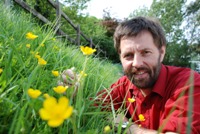Buttercups reveal age of meadow

Dr John Warren
23 June 2009
Last summer Dr Warren launched a UK wide appeal in the press, including The Times, and on TV and radio, which prompted thousands of people to go out into the fields to count the number of petals on buttercups.
The task set by Dr Warren was simple: count the number of creeping buttercup plants (Ranunculus repens) with extra petals, i.e. more than 5, in a sample of 100. The evidence was required to prove his hypothesis that the number of buttercups with more than 5 petals could provide the basis for calculating the age of the meadow.
Writing in the latest edition of the Annals of Botany Dr Warren presents his findings and argues that for every 100 buttercups in a field, seven years can be added to the age of the meadow for each flower with too many petals.
The creeping buttercup was selected for the study because much of its reproduction is through cloning itself.
“Each of the flowers should have five petals but mutations can cause it to have several more”, said Dr Warren. “Mutations often occur when the plants clone themselves and the genetic glitches are cumulative, meaning that the older a field is the more ragged the buttercups become.”
“This elegant low-tech science will be of use to historians and natural historians alike in helping understand our past and how diversity changes over time”, he added.
The technique has been demonstrated to work for fields up to 200 years old and it is thought that it could be used to identify meadows that have been untouched by ploughs for up to 1,000 years. Dr Warren now hopes it can be used to identify the oldest grassland in Britain.
It is unlikely, however, to work for fields older than 1,000 years because the cloned population is unlikely to make up much more than 50 per cent of a meadow's buttercups.
Of the thousands of reports sent to him by the public only 204 were selected for the study. Among the oldest grassland dated so far by Dr Warren is an open area within Roughetts Wood, near Chepstow, and a pathway leading to it. Records show that neither has been dug up for at least 200 years and probably longer.
Similarly, buttercup mutations in a field belonging to Llandrygarn School on Anglesey showed it to be more than 30 years since it was ploughed. Records showing the school took over the field from a neighbouring farm more than 30 years ago corroborated the dating.
The shortage of records makes the buttercup method more valuable because having been tested against fields of known ages it can be used for those where there are no relevant documents.
A method of estimating the age of hedgerows was developed several decades ago. Called Hooper’s Rule, it allows conservationists to judge the age by counting the number of woody species of plants.



